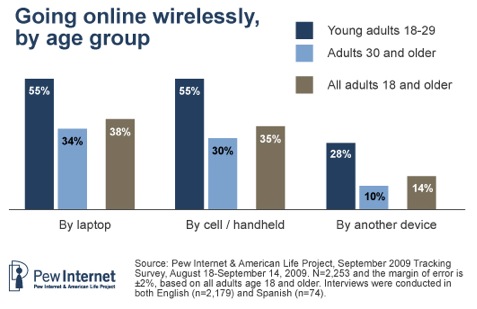
We all know that Generation Y uses technology to connect with the world around them in more diverse ways and in greater numbers than any other age group. But how can marketers tap into this gadget-savvy, brand-aware demographic? The following statistics, taken from four recent reports listed below, provide an insight into the complex world of 13-24 year-olds.
Brand awareness
- 66% would look up a store after learning their friend had checked in. (Mr Y)
- 43% have liked more than 20 brands on Facebook. (Mr Y)
- 65% report researching the next model for their current product, immediately after making a purchase (Mr Y)
- 71% report having liked a brand on Facebook just to receive an offer (Mr Y)
- Social Media
- 91% make their Facebook Places and Foursquare check-ins public. (Mr Y)
- 52% have over 300 friends on Facebook. Top 10%, over 1,000. (Mr Y)
- 58% use Twitter “all the time” (Mr Y)
- 40% visit Facebook more than 10 times per day. (Mr Y)
- 73% only consider someone a “friend” if they have hung out in person. (Mr Y)
- 76% spend over an hour on Facebook every day (Mr Y)
Gadget Ownership
- 89% own a laptop (Mr Y)
- 96% of undergraduates owned a cell phone in 2010, vs. 82% of the adult population.
- The vast majority of undergrads possessed a laptop and an iPod or MP3 player, too, at 88% and 84%, respectively. (PI)
- Adults younger than age 30 are more likely than those age 30 and older to own a cell phone—93% of young adults own cell phones compared with 80% of their older counterparts. (PI)
- Nearly seven in ten (69%) teens ages 12-17 have a computer (PI)
- Nearly four in five teens (79%) have an iPod or other mp3 player (PI)
- 80% of teens between the ages of 12 and 17 have a game console like a Wii, an Xbox or a PlayStation. (PI)
- Over one-quarter of students listed their laptop as the most important item in their bag—almost three times the number of students who chose textbooks. (CS)
- Among student tablet owners, 86% believe tablets help them study more efficiently, and 76% said tablets help students perform better in class. (CS)
- 62.7% of US undergraduates surveyed had an internet-capable handheld device. (CS)

Technology usage
- 67% access Facebook from their smart phone (Mr Y)
- 59% visit Facebook during class (Mr Y)
- 40% use Pandora (Mr Y)
- 73% earn virtual currency (Facebook Credits (36%), Farmville Cash (25%) and Microsoft Points (17%) rank among the most popular.) (Mr Y)
- 75% upload photos via mobile (Mr Y)
- 80% use 2 or more devices simultaneously while watching TV (Mr Y)
- 93% of teens with a desktop or laptop computer use the device to go online (PI)
- 21% of teens who do not otherwise go online say they access the internet on their cell phone. 41% of teens from households earning less than $30,000 annually say they go online with their cell phone. Only 70% of teens in this income category have a computer in the home, compared with 92% of families from households that earn more. (PI)
- Only 5% plan on buying a PC, 1% use Gowalla, 12% use foursquare, and only 13% of incoming freshmen plan on getting a cable TV package.
- 38% of students surveyed said they could not go more than 10 minutes without checking their digital device—about the time it takes to walk to class. (CS)
- 62% of youth brand and technology decisions are influenced by friends and family (MY)

Mobile phone usage
- 75% of 12-17 year-olds now own cell phones. (PI)
- 75% send over 20 text messages per day (Mr Y)
Among all teens, the frequency of use of texting has now overtaken the frequency of every other common form of interaction with their friends. Fully two-thirds of teen texters say they are more likely to use their cell phones to text their friends than talk to them to them by cell phone. (PI)
Teens who have multi-purpose phones are avid users of those extra features. The most popular are taking and sharing pictures and playing music:
- 83% use their phones to take pictures.
- 64% share pictures with others.
- 60% play music on their phones.
- 46% play games on their phones.
- 32% exchange videos on their phones.
- 31% exchange instant messages on their phones.
- 27% go online for general purposes on their phones.
- 23% access social network sites on their phones.
- 21% use email on their phones.
- 11% purchase things via their phones. (PI)
Half of teens send 50 or more text messages a day, or 1,500 texts a month, and one in three send more than 100 texts a day, or more than 3,000 texts a month. (PI)
15% of teens who are texters send more than 200 texts a day, or more than 6,000 texts a month. (PI)
Boys typically send and receive 30 texts a day; girls typically send and receive 80 messages per day. (PI)
Globally, there are 1.8 billion mobile phone owners aged under 30 (MY)
The global youth mobile market is worth $360 billion annually – 10x the size of the global recorded music industry (MY)
62% of all youth handset purchase decisions are influenced by peers not advertising (MY)
By 2012, one in five of the world’s mobile phone owning youth will be living in India (MY)

Privacy
While they are more likely to share photos of themselves (84%), their sexual orientation (69%), and relationship status (78%), they are still very unlikely to make their physical location, what products they have purchased, or their mailing address public. (Mr Y)
Sources
- Pew Internet & American Life Project reports: Teens and Mobile Phones (April 2010) and Social Media and Young Adults (PI)
- E-Marketer’s report College Students: The Gadget Generation, which cites a March 2011 survey done with Wakefield Research and textbook provider CourseSmart (CS)
- Mr Youth’s report Meet the Class of 2015 (Mr Y) researching the attidudes of 18-year olds. (Mr Y)
- Mobile Youth Report 2011, which defines ‘youth’ as under-30s (MY)
image credit: Marcio Eugenio via shutterstock
➤ Read Next: The top 30 stats you need to know when marketing to women
Get the TNW newsletter
Get the most important tech news in your inbox each week.